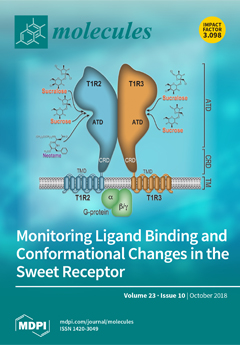1
UPM-MAKNA Cancer Research Laboratory, Institute of Bioscience, Universiti Putra Malaysia, 43400 UPM Serdang, Selangor, Malaysia
2
Unit of Genetics and Molecular Biology, Institute of Biological Sciences, Faculty of Science, University of Malaya, Jalan Universiti, 50603 Kuala Lumpur, Malaysia
3
Pharmacy Department, Faculty of Medicine, University of Malaya, 50603 Kuala Lumpur, Malaysia
4
Center of Natural Product Research and Drug Discovery (CENAR), University of Malaya, 50603 Kuala Lumpur, Malaysia
5
Department of Food Science, Faculty of Food Science and Technology, Universiti Putra Malaysia, 43400 UPM Serdang, Selangor, Malaysia
6
Chemistry Department, Faculty of Science, Universiti Putra Malaysia, 43400 UPM Serdang, Selangor, Malaysia
7
Laboratory of Molecular Biomedicine, Institute of Bioscience, Universiti Putra Malaysia, 43400 UPM Serdang, Selangor, Malaysia
8
Laboratory of Food Safety and Food Integrity, Institute of Tropical Agriculture and Food Security, Universiti Putra Malaysia, 43400 UPM Serdang, Selangor, Malaysia
Abstract
Natural products, either pure compounds or standardized plant extracts, have provided opportunities for the discovery of new drugs. Nowadays, most of the world’s population still relies on traditional medicines for healthcare purposes. Plants, in particular, are always used as traditional medicine, as they
[...] Read more.
Natural products, either pure compounds or standardized plant extracts, have provided opportunities for the discovery of new drugs. Nowadays, most of the world’s population still relies on traditional medicines for healthcare purposes. Plants, in particular, are always used as traditional medicine, as they contain a diverse number of phytochemicals that can be used for the treatment of diseases. The multicomponent feature in the plants is considered a positive phytotherapeutic hallmark. Hence, ethnopharmacognosy has been the focus for finding alternative treatments for diseases.
Melicope lunu-ankenda, also known as
Euodia lunu-ankenda, is widely distributed in tropical regions of Asia. Different parts of
M. lunu-ankenda have been used for treatment of hypertension, menstrual disorder, diabetes, and fever, and as an emmenagogue and tonic. It has also been consumed as salad and as a condiment for food flavorings. The justification of use of
M. lunu-ankenda in folk medicines is supported by its reported biological activities, including its cytotoxic, antibacterial, antioxidant, analgesic, antidiabetic, and anti-inflammatory activities. This review summarizes the phytochemical compounds isolated from various parts of
M. lunu-ankenda, such as root and leaves, and also its biological activities, which could make the species a new therapeutic agent for some diseases, including diabetes, in the future.
Full article






